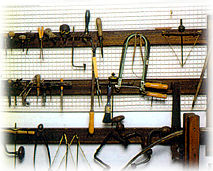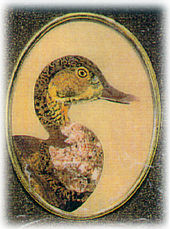
Trying to match up a tiny piece of hard stone
This does not mean that the art was unheard-of outside Florence and before the 16th century, it simply acknowledges the fact that this very special kind of "mosaic" was promoted in and common to this city, on command of that avid experimentalist Francesco I, who was the second, highly intriguing Grand Duke of the Medici dynasty. He started to experiment with hard stones in his workshop at the Casino di San Marco, with the help of skilled artists such as Francesco del Tadda. The latter had discovered a new way of hardening steel tools, and was therefore able to chisel exceptionally hard materials such as porphyry.

Cutting the hard stones with a bow of chestnut wood and metal wire
After Francesco I's early (and mysterious) death, his brother and successor, Ferdinando I expressed his interest in hard stones in a more practical and rational way. He created a completely new institute that was to specialize in collecting, working, studying and restoring hard stones. This was the Opificio delle Pietre Dure, the year was 1588, and its premises were, for over two centuries, in the UffiziPalace. The new Grand Duke had already conceived the ambitious plan of a vast, octagonal chapel, similar to a "modern" Pantheon. It was to be situated behind the apse of San Lorenzo, covered by the second largest dome in Florence, and destined to be the Medici family burial place. This so-called Cappella dei Principi, designed by Nigetti, and built at the beginning of the 17th century, had its inside walls, pillars, altarpieces etc. all covered in inlaid hard stones, an almost impossible job, in view of its technical difficulty and sheer financial cost. This "impossible job"was the Opificio's main task during the next three centuries, and saw generation after generation of dedicated artists/artisans toil with the exacting labour of juxtaposing slices of coloured stone according to pre-set and usually complex designs: this was a way of painting, so to speak, not with brushes and paint, but with chisels and stone. While the Opificio continued in its "official" capacity even after moving to its present quarters in via degli Alfani, it was eventually to specialize in the restoration of works of art in stone and marble. At the same time, the institution set up its well-known restoration school which embraces all the materials used in art masterpieces. While all this was going on, a number of workshops were being set up in Florence by individual artisans to meet the growing demand for smaller works in hard stones.

Some of the old tools used to prepare the hard stones
A few botteghe of this type can still be found in the city and form one of its most interesting attractions. Their master craftsmen still work with incredibly "primitive", or rather, elementary tools. However the most important and irreplaceable requirements of this art are patience and skill, plus a firm and sensitive hand.

An example of "Florentine Mosaic"
It is impossible for works of "Florentine mosaic" to be of little value. The stones themselves are often semi-precious, and the hours involved on even a simple work would horrify a modern, industrial time-analyst. Keep in mind that when you buy a piece of hard stone "mosaic", you are also buying a fragment of Florence, her history, her glory. Moreover you are capturing a part of the city's intellectual curiosity for creating whatever may lead to beautiful results that are worthy of man, in this case they are captured in stone.
